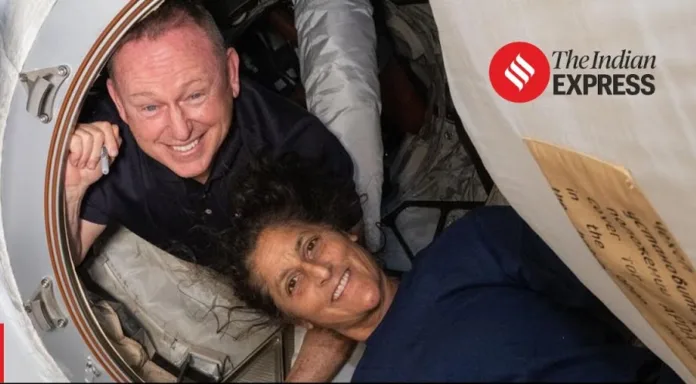Sunita Williams and Butch Wilmore’s brief space mission turns into an unexpected months-long ordeal as Boeing Starliner capsule issues delay their return to Earth.
In June 2024, astronauts Sunita Williams and Butch Wilmore embarked on what was intended to be a routine, week-long mission aboard the International Space Station (ISS). They travelled in Boeing’s Starliner capsule, a craft designed to transport astronauts to and from the ISS efficiently. However, the mission took an unexpected turn when faulty thrusters on the Starliner capsule disrupted their plans, leaving the astronauts stranded in space for over two months.
The thruster malfunction became apparent shortly after the Starliner docked with the ISS. Initially, the astronauts and ground control anticipated a quick resolution to the problem. But as days turned into weeks, it became clear that the issue was more complicated than initially thought. Boeing’s engineers on Earth worked tirelessly to diagnose and repair the malfunction from afar, but the complexity of the situation meant that a swift fix was not feasible.
As the mission extended beyond its original timeline, Williams and Wilmore found themselves in a unique position. With their planned activities completed, they had to adjust to a prolonged stay in orbit. For Williams, a veteran astronaut with extensive experience on the ISS, the extended mission posed both physical and psychological challenges. Wilmore, who had also spent significant time in space during previous missions, relied on his experience to cope with the uncertainty.
Despite the challenges, the astronauts made the best of their extended time on the ISS. They participated in additional scientific experiments and used their time to conduct maintenance tasks that had not been part of their original mission. The prolonged stay also provided them with more opportunities to communicate with students and the public, sharing their experiences of life in space.
Meanwhile, the situation on the ground grew increasingly tense. The delay not only posed a challenge for Boeing, which has been under scrutiny following previous setbacks with the Starliner program, but it also raised concerns within NASA. The space agency had hoped the Starliner would become a reliable alternative to SpaceX’s Dragon capsule for ferrying astronauts to the ISS, but the extended delay put this goal into question.
As days turned into months, discussions about alternative ways to bring the astronauts home became more urgent. While returning in the Starliner remained the preferred option, NASA and Boeing began to explore other possibilities, including using a Russian Soyuz capsule or SpaceX’s Dragon capsule to retrieve the astronauts.
Ultimately, the extended mission underscored the inherent risks and uncertainties of space travel. For Williams and Wilmore, it was a test of endurance and adaptability, but they remained focused on their mission, displaying the resilience and professionalism that have become hallmarks of space exploration.
Analysis:
Political:
The extended mission has significant political implications, particularly in the context of U.S. space policy and international space relations. Boeing’s issues with the Starliner capsule have come at a critical time when NASA is seeking to reduce its reliance on Russian Soyuz capsules for transporting astronauts to the ISS. The delay may increase political pressure on Boeing to address the Starliner’s technical problems promptly. It also opens the door for SpaceX, Boeing’s main competitor in the commercial space sector, to strengthen its position as NASA’s go-to provider for crewed spaceflights. Moreover, the situation could influence future funding decisions in Congress, as lawmakers weigh the need for a diverse range of spacecraft against the financial and technical challenges of developing new space technology.
Social:
Socially, the extended mission has sparked discussions about the psychological and emotional toll of space travel. The isolation and uncertainty faced by the astronauts have resonated with people on Earth, especially in the context of recent global events that have left many feeling isolated and uncertain. The astronauts’ ability to maintain their composure and continue their work despite the unexpected delay serves as a powerful example of human resilience. This situation has also reignited public interest in space exploration, with many people following the astronauts’ journey closely and expressing support for them on social media.
Racial:
From a racial perspective, Sunita Williams’ extended mission is noteworthy. As a prominent figure of Indian descent in the American space program, her presence on the ISS highlights the increasing diversity within NASA and the broader space industry. Williams’ extended stay in space adds to her legacy as one of the few astronauts of South Asian heritage to have undertaken long-duration missions. This could inspire a new generation of young people from diverse backgrounds to pursue careers in STEM fields and space exploration.
Gender:
The gender dynamics of space travel are also at play in this story. Sunita Williams, as one of the few female astronauts with extensive experience in space, continues to break barriers in a traditionally male-dominated field. Her extended mission serves as a reminder of the important contributions women are making to space exploration. It also highlights the ongoing challenges women face in this field, from dealing with the physical demands of space travel to navigating the pressures of being under constant public scrutiny. Williams’ resilience and professionalism throughout the ordeal set a strong example for aspiring female astronauts and scientists.
Economic:
Economically, the delay has significant implications for Boeing and the broader commercial space industry. The technical issues with the Starliner capsule have already caused delays and increased costs for Boeing, and the extended mission further complicates the company’s efforts to establish the Starliner as a reliable spacecraft for NASA. This situation could lead to financial losses for Boeing and may impact its stock prices and investor confidence. Furthermore, the delay could have ripple effects across the commercial space sector, as other companies and government agencies reassess their own timelines and budgets in light of Boeing’s challenges. On the other hand, this situation could present an economic opportunity for SpaceX, which may gain more contracts and funding from NASA as a result of Boeing’s difficulties
